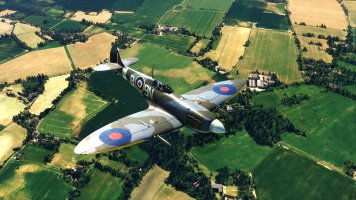You are using an out of date browser. It may not display this or other websites correctly.
You should upgrade or use an alternative browser.
You should upgrade or use an alternative browser.
Flying Irons Spitfire IX - Overnight Update (3/28)
- Thread starter collensr
- Start date
collensr
SOH-CM-2025
Have re-downloaded and that seems to have cured most of the the animations issues although at low revs I think the prop animation is looking a bit like "the old" Miss Virginia"!
Anyway more seriously my flying skills have degraded so badly that I can't seem to keep the Spit straight on T/O any longer. I need to get back to those UTube videos and re-learn this one. I don't remember it swinging so wildly to the left at the start of the take off run.
Anyway more seriously my flying skills have degraded so badly that I can't seem to keep the Spit straight on T/O any longer. I need to get back to those UTube videos and re-learn this one. I don't remember it swinging so wildly to the left at the start of the take off run.
jcweston351
Members +
Flying Iron just keep getting better & better... This is now really fun to taxi pretty much how I think the real plane would be, I also ground looped it on the landing run out, just didn't quite catch it in time in a slight cross wind just as a real tail dragger would go. It was scary real how it went on me! This is by far the best warbird in MSFS!
For me too. I installed the prop textures of the previous version and all is well.Interested to get some feedback on this. On my system it seems to have messed up the prop/cowling animation and also the prop blur?
jankees
SOH-CM-2025
Wing_Z
Charter Member 2011
Remains surely the best Warbird available - reading the changelog boggles the mind.
I tend to agree, could I ask which those are?For me too. I installed the prop textures of the previous version and all is well.
jcweston351
Members +
Hmmm, don't spitfires have wooden propellers?
Daube
SOH-CM-2025
Wasn't it only for Mk.1 ?Hmmm, don't spitfires have wooden propellers?
shotgunshack
SOH-CM-2023
I think all modern Warbirds have wooden props to lessen engine damage in a wheels-up landing. Difficult to animate.
Bomber_12th
SOH-CM-2025
I think there may have been a misunderstanding amongst the FlyingIron devs with regard to the Spitfire Mk.IX prop, as metal blades on a Spitfire Mk.IX are really just wrong. The only time production Spitfires used metal prop blades, as far as I know, was the Spitfire Mk.I and Mk.II when fitted with the three-bladed De Havilland two-pitch propeller. From the Spitfire Mk.V onward, including the Griffon examples, they used wood laminate prop blades. Both during World War Two, and today's flying examples, all Mk.IX Spitfires I'm aware of have only ever been fitted with wood prop blades. The main portion of the blades were, and are still to this day, made of a high-strength birchwood laminate, with the root of the blades being made of mahogany. When there is a nose-over, or belly landing, the props splinter or completely break off at the root, and being made of wood, there is far less chance of shock loading the engine as opposed to American fighters and bombers, for instance, which all use metal props still to this day (save for the XP-82 restored by Tom Reilly, which uses wood blades made to match the same profile as the original Aeroproducts metal blades).
Speaking of wood props, I think Classic Aircraft Simulations did a wonderful job of modeling/animating a splintered wood prop on their J-3 Cub, when the prop comes into contact with the ground.
Speaking of wood props, I think Classic Aircraft Simulations did a wonderful job of modeling/animating a splintered wood prop on their J-3 Cub, when the prop comes into contact with the ground.
Last edited:






